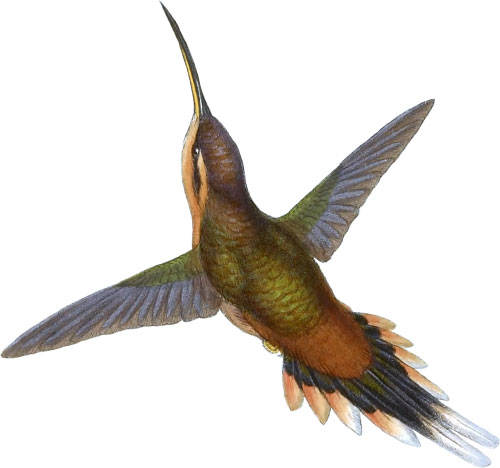The fact of Central America having a fauna peculiarly its own has been frequently mentioned in the pages of the present work; and so decidedly is this the case, that while it comprises certain species and even genera which do not exist elsewhere, the species there found are generally representatives of others inhabiting South America proper, or that portion of the continent to the southward of Panama.
Numerous, however, as are the little Phaëthornes inhabiting the latter country, only one has, so far as is yet known, been found in the former—namely the P. Adolphi. M. Sallé, while residing at Cordova, during his recent visit to Mexico, collected numerous specimens of this bird, and appears to have subjected them to a careful examination of their internal parts, in order to ascertain the sexes with certainty; and, if reliance can be placed upon his investigations, it would seem that all those with short and rounded tails are males, while the females have the two central feathers more prolonged, and the lateral ones with a dark zone between their bronzy bases and buff tips. Supposing this information to be correct, a highly interesting fact has been ascertained, and one which will form a key as it were to the sexual markings of other allied species, some of which present similar characters; and it becomes necessary, now, to ascertain if the larger members of the genus Phaëthornis and those of Glaucis are subjected to the same law.
Besides specimens from Cordova, I have received many others from a very different locality, Guatemala, whence at least ten individuals were transmitted to me by George Ure Skinner, Esq.; these, however, had not been subjected to dissection. A locality still farther south may, if I mistake not, be assigned to this bird, Mr. Lawrence of New York having a specimen, collected in Veragua, which I believe to be identical with the present species, and which was procured by Dr. Merritt, the discoverer of the interesting albocoronata; the whole of Central America, therefore, from the Isthmus of Panama to Mexico, may be said to be inhabited by this bird. The species to which it is most nearly allied is the Phaëthornis griseogularis, from which it differs in its larger size, the still darker and more smoky colouring of the under surface, and the uniform deep olive-green colouring of the tail, the lateral feathers of which are not so largely tipped with buff.
Head, upper surface and wing-coverts dark bronzy-brown; tail-coverts rufous; tail dark bronzy-green tipped with buff, fading into white at the extremity; wings purplish-brown; ear-coverts dark brown; under surface buff, with a wash of grey on the throat and breast; upper mandible and apical half of the lower mandible black; basal half of the latter bright yellow; legs and feet brownish-yellow.
The Plate represents the birds of the natural size.
 Phaëthornis Longuemareus
Longuemare’s Hermit
Phaëthornis Longuemareus
Longuemare’s Hermit
 Phaëthornis Amaura
Amaura Hermit
Phaëthornis Amaura
Amaura Hermit
 Phaëthornis viridicaudata
Green-tailed Hermit
Phaëthornis viridicaudata
Green-tailed Hermit
 Paëthornis zonura
Southern Hermit
Paëthornis zonura
Southern Hermit
 Phæthornis griseogularis
Grey-throated Hermit
Phæthornis griseogularis
Grey-throated Hermit
 Phaëthornis striigularis
Stripe-throated Hermit
Phaëthornis striigularis
Stripe-throated Hermit
 Phaëthornis obscura
Obscure Hermit
Phaëthornis obscura
Obscure Hermit
 Phaëthornis nigricinctus
Belted Hermit
Phaëthornis nigricinctus
Belted Hermit
 Phaëthornis Episcopus
Bishop Hermit
Phaëthornis Episcopus
Bishop Hermit
 Phaëthornis Eremita
Little Hermit
Phaëthornis Eremita
Little Hermit
 Phaëthornis pygmæus
Pigmy Hermit
Phaëthornis pygmæus
Pigmy Hermit
Featuring all 422 illustrated species from John Gould’s A Monograph of the Trochilidæ, or Family of Humming-Birds arranged by color.